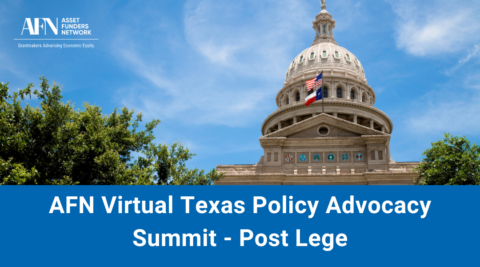Recent Supreme Court decisions are reshaping the landscape of economic justice, creating both challenges and opportunities for us to navigate together. As systemic frameworks evolve, the collective creativity, collaboration, and commitment of funders are vital in driving impactful change at the state, county, and city levels.

FROM THE PRESIDENT AND CEO
November 2024
When AFN members think about innovation or system change, it starts with knowing the facts, understanding the root causes, seeing the systemic framework, and supporting narratives to understand the levers that investments can cause to create change or create new ways to achieve the desired inclusive and just outcomes. To achieve the desired change in wealth-building outcomes requires understanding the various systemic elements to target the key levers for innovation at the scale or level the funder or collaboration of funders and stakeholders can achieve. Advancing economic justice, equity, and asset building most often rely upon the system growing inclusively, operating differently, opening up to excluded communities in targeted ways, or being replaced in ways that produce greater economic justice.
Acting on this approach requires a predictable system. A system involves private practices or policies, cultural beliefs, and shared myths, as well as public elements such as laws or regulations, enforcement, or implementation practices. Predictability can be the status quo that preserves advantages and disadvantages, but it also allows businesses to plan, expand, and move forward and funders to invest for predictable outcomes. Part of a system change examination entails understanding the predictable system created by Federal laws and regulations or policies as well as the more detailed or at times demanding laws, rules, and practices at the state, county, or city levels. AFN’s local chapters are intentionally designed as collaborative tables, bringing together funders and financial institutions as key stakeholders that can plan for the needed and desired changes in the local context that produce more equitable and economically just outcomes.
In the past few years, the Supreme Court has upended predictability in several areas of importance – reproductive rights, clean water and air, voting rights, the meaning of the First and Second Amendments, and the separation of powers. They each warrant attention, yet for AFN the most concerning are those with an impact on fulfilling the economic security and wealth-building potential and opportunity for all Americans – particularly those who have been excluded due to race, ethnicity, immigration status, age, or gender.
In the following cases decided in the last term, the Court decided to reduce predictability:
- The 40-year precedent of “Chevron deference” to agency interpretations in areas of their expertise was eliminated in Loper Bright Enterprises – never mind that Congress, states, and business have all relied on this framework since the Reagan era. Instead, anyone can challenge a rule and the parties’ evidence and arguments will inform the judge to be the final arbiter to determine if the agency had the authority and if it is a valid interpretation of the law. The Court provided no new standard for a judge to apply in determining whether to uphold a rule.
- In Jarkesy, the Court ruled that in a securities fraud claim, the SEC could not proceed under a “public rights” exception to a target’s right to a jury trial, despite the fact that Congress had expanded under the Dodd-Frank Consumer Protection Act. So instead of an administrative adjudication, the SEC would need to proceed in Court which is more time consuming and resource intensive tying up agency resources and probably resulting in fewer enforcement actions and settlements. Many other agencies rely on administrative adjudications affecting economic security, fraud, and legal compliance that are likely to be impacted.
- In Corner Post, Inc., the Court decided that the Federal Reserve’s reliance on the Congressionally created statute of limitations of six years to challenge agency final rulemaking was extended to permit a new entity to challenge decades-old rules. So a new entity can now challenge a rule it objects to no matter how long and well established. This effectively eliminates the statute of limitations to challenge agency rulemaking.
- In Ohio v. EPA, the Court opted to enjoin EPA rulemaking until the Courts considered the objections thereby seemingly encouraging early challenges prior to enforcement and incentivizing protracted rulemaking.
Together these decisions swept away decades of predictability to shift power away from federal agencies (and apparently from Congress), transferring that power to the courts.
And as a practical consideration – litigation challenging a rule and any appeals may take five years or more. But now, even that fails to settle a matter to be predictable. Because a newly created plaintiff can challenge the “final” rule upheld in the prior court decision with new theory under Loper. The implications of these decisions upending predictability for the rules governing the economy extend to all federal agencies (SEC, FTC, HHS, DOL, NLRB, CFPB, EPA, USDA, EDA, DOE, NCUA, SBA, and others) such that environmental law, securities law, internet rules, labor law, consumer protection, banking law —may never be settled law.
As I think about this and the role of philanthropy, financial institutions, and community, I realize that while some of what has been predictable has been taken away, the complexity and strength of our nation’s federalism and institutions also point to paving other paths forward – if we can collaborate and meaningfully commit. In the end, these rulings affect the federal government, but states, counties and cities can act to advance economic justice.
Just as more than half of the states have increased the Federal minimum wage and many states are acting to incentivize decarbonization, there is great possibility for more. Local and state governments can act to expand protections against wage and saving garnishment, end Medicaid liens on houses, reduce medical debt abuses, create protections against fraud, or incentivize private investments in small business and correct for past disinvestment in communities. States can also adopt baby bonds and guaranteed income to ensure a thriving economy, make in-state post-secondary education tuition-free, invest in expanding well-paid child care, plan for a workable care economy approach like Washington state, or the Colorado or Maryland paid family leave approaches. These reforms promoting security and prosperity could pave the way to future multi-state or national systems desired by voters and businesses.
AFN chapters are a table that will continue to support new policies and experimentation. Strategies can be tested and implemented. States can share at both the public and narrative levels and across AFN and aligned networks. Funders and financial institutions can work together to assess, fund research, invest in, and advocate for creative and lasting changes in the local economies to be more inclusive and just.
Join us to dig in and make a shared, inclusive, and prosperous future a reality for which we can all be thankful.



